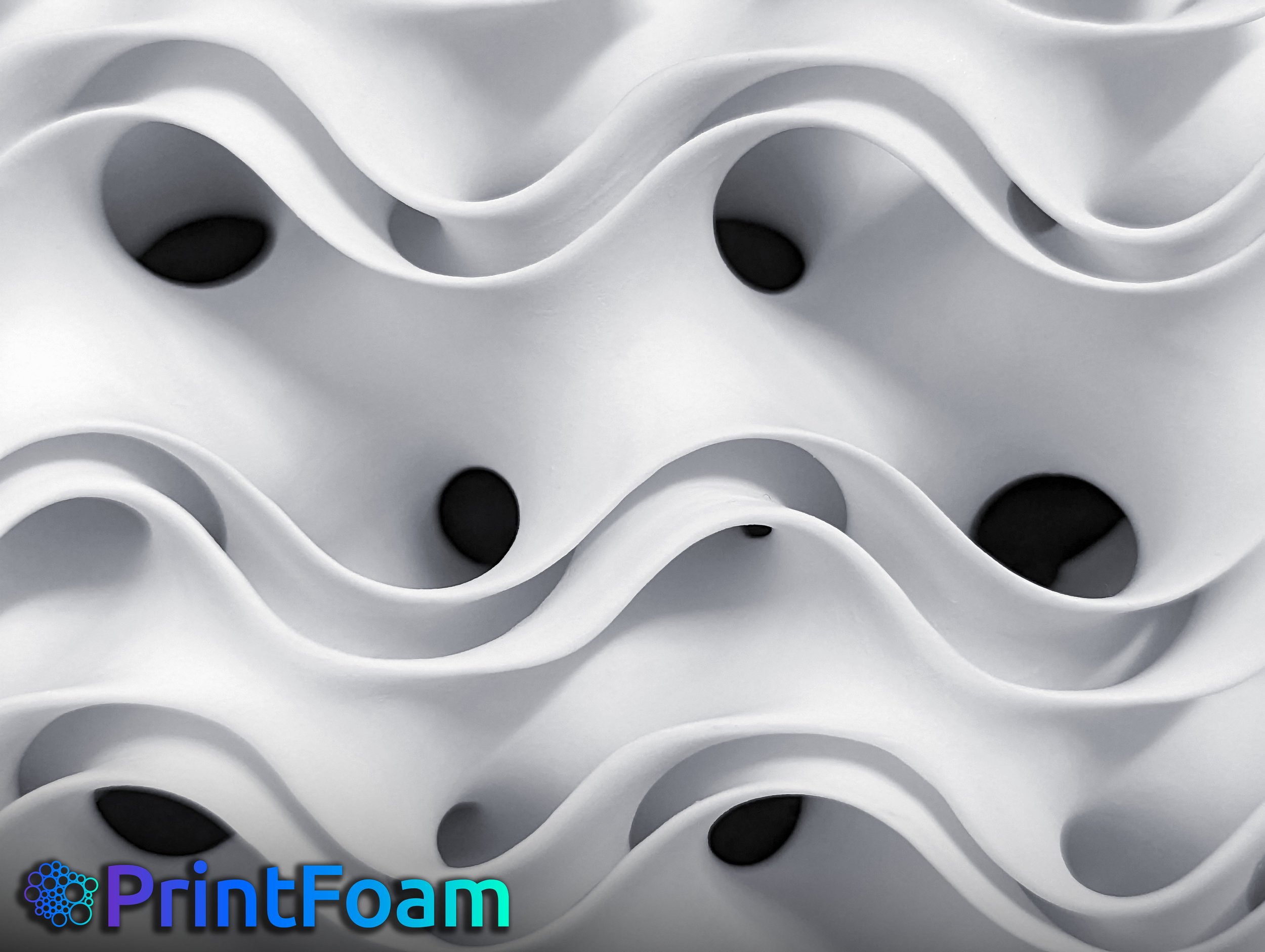Materials Spotlight: EcoFoam
PrintFoam Co-Founder and CEO Matthew Pearlson:
“EcoFoam isn’t designed to last forever. It breaks down, and we’re glad it does.”
PrintFoam is committed to creating a better future. We are dedicated to foundational principles in sustainability and diversity. So begins our Commitments page – and so began our mission.
It can be easy for any company, especially in the 3D printing space, to note that sustainability is a priority. After all, the full process is called additive manufacturing. A simple definition there, which many 3D printing companies rely on, is that only* the necessary material for a build need be used.
It can be too easy to ignore that asterisk, though, in “only*”.
In many cases, the “necessary material” also includes support structures that become waste, along with failed builds. Foundationally, 3D printing emerged as a rapid prototyping technology; many industry “old timers” still say “RP” instead of “AM”. Prototypes are ultimately discarded.
We’re not pretending we’re waste-free. We want to be realistic while staying true to our PrintFoam foundations, ethos, and ethics. We’ve already created a new process to foam and 3D print materials – so why not create new materials while we’re at it?
Our Co-Founder and CTO, Dr. David Walker, is an AM materials expert – you can find him at any trade show as the one smelling photopolymer parts to immediately understand their chemistry. His deep expertise in photopolymers is a sight to behold, especially when he’s in action in the lab. Formulating, reformulating, testing, validating: no chemical stone is left unturned.
David has developed EcoFoam, our first proprietary, certifiably bio-sourced material line.
EcoFoam materials mark another tangible step on our PrintFoam roadmap.
As we continue to make large-scale additive manufacturing a reality with the time, quality, and materials that can actually impact manufacturing and end-use applications, we want to do it well. We want to do good. EcoFoam moves our needle on impact.
We also have more applications, more formulations, and more industry involvement in our line of sight. In the not-too-distant future, we hope to align with sustainability-minded organizations and further formalize life cycle analysis (LCA) and other validated studies and proofs of concept.
EcoFoam
Think of Styrofoam: you know it, and if you’re like most of us who shop online or have ever gotten a coffee to go, you’ve used it extensively.
Styrofoam is one and done.
Not our style.
Styrofoam and other foamed polystyrene products are familiar – if not ubiquitous. That ubiquity though, doesn’t end with product end-of-life; a quick Google of “Styrofoam biodegradability” is a fast lesson in truly depressing waste stream realities.
While Styrofoam / EPS (expanded polystyrene) is actually one of the most valuable and one of the easiest-to-recycle polymers, the problem is that it's often contaminated with food waste, gets sent to a landfill, and it never degrades. It's not a problem of 'recyclability' of plastics. The problem is that most plastics are never properly recycled and they can't degrade after their life cycle.
Enter EcoFoam. With familiar properties – think foamed polystyrene – EcoFoam offers performance that’s designed to break down.
From its certifiable roots in known, bio-sourced material components, EcoFoam is formulated with its entire life cycle in mind, formulation-cradle to breakdown-grave.
Not every product made is intended to last forever. Planned obsolescence aside, many parts have a very finite purpose. Once they fulfill that purpose, they are discarded. It’s that discarding that proves tricky though, as many products – we’re looking at you, Styrofoam – don’t exactly go quiet into that good night upon disposal. They linger in the earth, adding more microplastics and more unconscionable waste to the world.
EcoFoam is made to be thrown away responsibly. Upon disposal, it breaks down in soil, adding a nice circle of life moment where it can be printed for a (finite) good reason, broken down into soil that grows into new plants that will in turn become EcoFoam all over again, be foamed, and go back to use maybe pulling carbon dioxide form the atmosphere.
EcoFoam Applications
EcoFoam offers differentiation in terms of material properties.
Print it soft and squishy (with those beautiful real foam bubbles), print it hard and rigid, print it how you need your part.
Prototype with EcoFoam. It’s ripe for iterative design – and a predetermined shelf life.
Metal cast with EcoFoam. It will burn out cleanly, leaving a beautifully detailed metal part.
Manufacturing for any application that has a good reason to be 3D printed – dimensional accuracy, metamaterial structures, performance, multifunctionality: EcoFoam can do it.
We’ve formulated EcoFoam to be printable with the same minimum feature size, the same XY resolution, and the same bubble size we’ve already validated through our process. The quality remains, only now it does so with compostability in sight (we’re still testing there).
Sound too good to be true? Let’s make it better – EcoFoam is also printable on conventional desktop 3D printers.
EcoFoam is a bio-based / bio-sourced material, designed to keep things out of the Great Pacific Garbage Patch. Our world doesn’t need more microplastics, more floating plastics – or more faux recycling claims. (It’s a sad reality that most things don’t actually get recycled, whichever bin you drop them in.)




